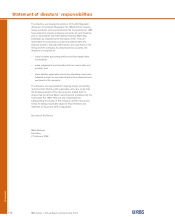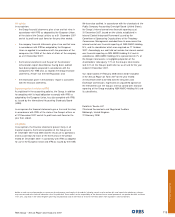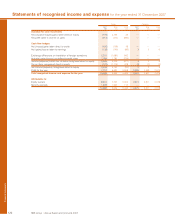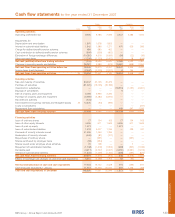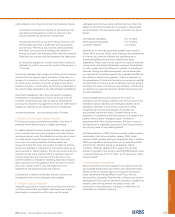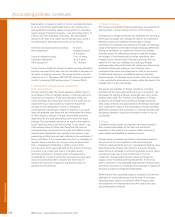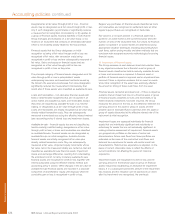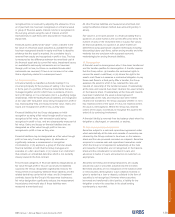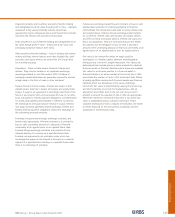RBS 2007 Annual Report Download - page 127
Download and view the complete annual report
Please find page 127 of the 2007 RBS annual report below. You can navigate through the pages in the report by either clicking on the pages listed below, or by using the keyword search tool below to find specific information within the annual report.
125
RBS Group • Annual Report and Accounts 2007
Financial statements
Card related services:fees from credit card business include:
Commission received from retailers for processing credit
and debit card transactions: income is accrued to the
income statement as the service is performed.
Interchange received: as issuer, the Group receives a fee
(interchange) each time a cardholder purchases goods
and services. The Group also receives interchange fees
from other card issuers for providing cash advances
through its branch and Automated Teller Machine networks.
These fees are accrued once the transaction has taken place.
An annual fee payable by a credit card holder is deferred
and taken to profit or loss over the period of the service i.e.
12 months.
Insurance brokerage: this is made up of fees and commissions
received from the agency sale of insurance. Commission on
the sale of an insurance contract is earned at the inception of
the policy as the insurance has been arranged and placed.
However, provision is made where commission is refundable in
the event of policy cancellation in line with estimated cancellations.
Investment management fees: fees charged for managing
investments are recognised as revenue as the services are
provided. Incremental costs that are directly attributable to
securing an investment management contract are deferred and
charged as expense as the related revenue is recognised.
Insurance premiums – see accounting policy 10 below.
4. Pensions and other post-retirement benefits
The Group provides post-retirement benefits in the form of
pensions and healthcare plans to eligible employees.
For defined benefit schemes, scheme liabilities are measured
on an actuarial basis using the projected unit credit method
and discounted at a rate that reflects the current rate of return
on a high quality corporate bond of equivalent term and
currency to the scheme liabilities. Scheme assets are
measured at their fair value. Any surplus or deficit of scheme
assets over liabilities is recognised in the balance sheet as an
asset (surplus) or liability (deficit). The current service cost and
any past service costs together with the expected return on
scheme assets less the unwinding of the discount on the
scheme liabilities is charged to operating expenses. Actuarial
gains and losses are recognised in full in the period in which
they occur outside profit or loss and presented in the
statement of recognised income and expense.
Contributions to defined contribution pension schemes are
recognised in the income statement when payable.
5. Intangible assets and goodwill
Intangible assets that are acquired by the Group are stated at
cost less accumulated amortisation and impairment losses.
Amortisation is charged to profit or loss over the assets’
estimated economic lives using methods that best reflect the
pattern of economic benefits and is included in depreciation
and amortisation. The estimated useful economic lives are as
follows:
Core deposit intangibles 6 to 10 years
Other acquired intangibles 5 to 10 years
Computer software 3 to 5 years
Expenditure on internally generated goodwill and brands is
written-off as incurred. Direct costs relating to the development
of internal-use computer software are capitalised once
technical feasibility and economic viability have been
established. These costs include payroll, the costs of materials
and services, and directly attributable overhead. Capitalisation
of costs ceases when the software is capable of operating as
intended. During and after development, accumulated costs
are reviewed for impairment against the projected benefits that
the software is expected to generate. Costs incurred prior to
the establishment of technical feasibility and economic viability
are expensed as incurred as are all training costs and general
overhead. The costs of licences to use computer software that
are expected to generate economic benefits beyond one year
are also capitalised.
Acquired goodwill being the excess of the cost of an
acquisition over the Group’s interest in the net fair value of the
identifiable assets, liabilities and contingent liabilities of the
subsidiary, associate or joint venture acquired is initially
recognised at cost and subsequently at cost less any
accumulated impairment losses. Goodwill arising on the
acquisition of subsidiaries and joint ventures is included in the
balance sheet caption ‘Intangible assets’ and that on
associates within their carrying amounts. The gain or loss on
the disposal of a subsidiary, associate or joint venture includes
the carrying value of any related goodwill.
On implementation of IFRS, the Group did not restate business
combinations that occurred before January 2004. Under
previous GAAP, goodwill arising on acquisitions after 1 October
1998 was capitalised and amortised over its estimated useful
economic life. Goodwill arising on acquisitions before
1 October 1998 was deducted from equity. The carrying
amount of goodwill in the Group’s opening IFRS balance sheet
(1 January 2004) was £13,131 million, its carrying value under
previous GAAP.
6. Property, plant and equipment
Items of property, plant and equipment are stated at cost less
accumulated depreciation (see below) and impairment losses.
Where an item of property, plant and equipment comprises
major components having different useful lives, they are
accounted for separately. Property that is being constructed or
developed for future use as investment property is classified as
property, plant and equipment and stated at cost until
construction or development is complete, at which time it is
reclassified as investment property.



